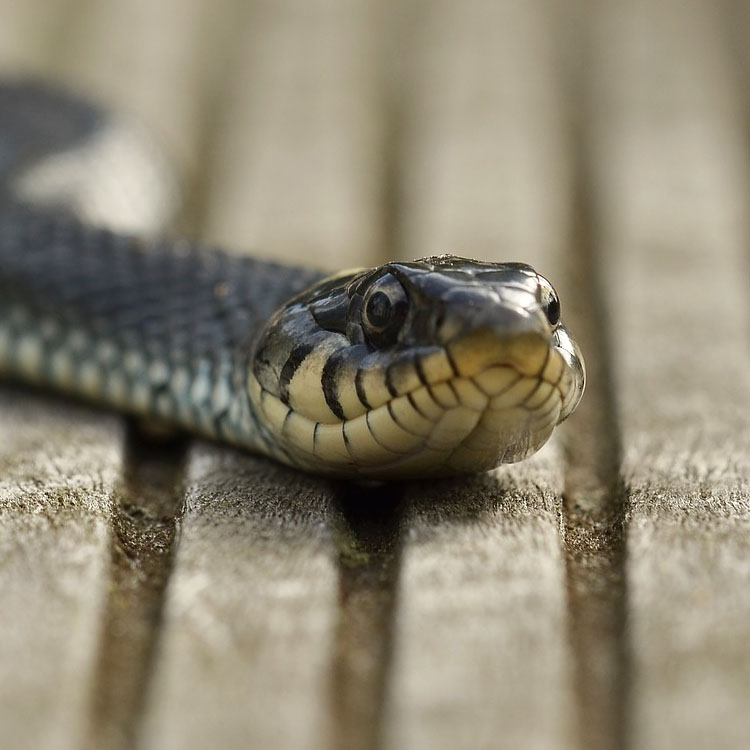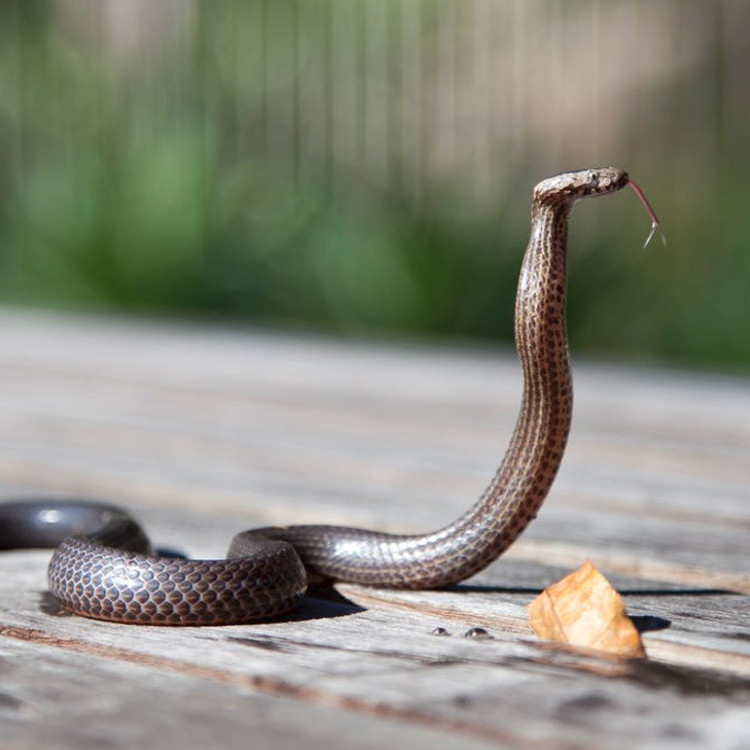Venomous snakes of Florida : Watch where you step!
There are 6 different species of snakes that occur naturally in the state of Florida. It is important to be able to identify these species. If you see a venomous snake in your yard or in your house, it is important to leave it alone and call an expert. It is very dangerous to attempt to remove or kill a venomous snake. Most snake bites occur when a person is trying to kill the snake.
The Copperhead is a small orange snake that only occurs in small pockets along the panhandle of Florida. If you do not live in the extreme north of western Florida, then you will not see this snake. They can be locally abundant and like to hide underneath rotting pine longs. They prefer damp areas. They can occasionally den under a house for extended periods of time- coming out for food and warmth every few days.
The Water Moccasin, also known as a Cottonmouth is the most common species of venomous snake and it is also the most difficult to identify. The water moccasin is a large-bodied snake that is nearly solid black. They can grow to be 5 feet long and as big around as an arm. Baby water moccasins are commonly seen in the springtime and have a slight pattern to them. The baby water moccasins will be lighter brown on the underside with broad tiger-like stripes coming up from the underbelly. Adults will be a solid dark brownish-green to black with very little pattern on them at all. They will have a large head with a distinct neck. Water snakes are a similarly patterned snake that will have a much smaller head that is roughly the same size around as the neck. The water moccasins can be found in ponds and small slow moving creeks. They prefer very dark water with lots of marginal plants or overhanging trees to give them plenty of places to hide.

Coral snakes are brightly colored snakes that have an alternating pattern of black- yellow-red-yellow-black. They tend to stick close to the ground or even bury themselves in leaves or loose soil. They are often found in gardens or near construction sites where the soil is being dug up. This disturbs the snakes and gets them to move.
There are three species of rattlesnakes in Florida. Pygmy rattlesnakes are small and light grey or silver colored with a black pattern along the length of the body and a little bit of orange along the head. They will be less than two feet long with a small rattle that will be difficult to hear. Eastern Diamondback rattlesnakes are a very large species of rattlesnake with a brown base color and a yellow pattern forming diamond shapes along the length of the body. The last species of rattlesnake is only found in the northern half of the state of Florida. The Canebrake (also called a Timber) rattlesnake is variable and can be dark brown to light grey with an orange stripe starting at the head and a dark chevron pattern continuing down the length of the body.
If a snake has a rattle, it will be venomous.
How to remove snakes
Snakes can be a serious problem. If you notice snakes (especially venomous snakes) or signs of snakes in or on your property, it is important to call a wildlife professional to remove them for your safety.
Snake trapping can be difficult for several reasons. Snakes are not attracted to bait so the traps must be placed in strategic locations that would entice the snake to go into the trap. This is usually done by placing a glue board underneath a coverboard that is only a few inches off of the ground. Water dwelling snakes such as cottonmouths (also known as Water moccasins) present a different set of challenges. Minnow traps set halfway in the water with fish in them can be used but the most effective way for us to remove snakes from a pond is manually using snake tongs or snake hooks. It is important to get a professional out to your property quickly so that we can more easily find the snakes for you.
Every snake trapping and removal job is different. Depending on the species and the property, traps might be placed in the house, in the attic, along the ground in the yard, in bushes, or in ponds. Pitfall traps, glue boards, and funnel traps are all different styles of trap that may be deployed as well. It is important to know what type of trap is the best for the given circumstances.
Another concern is what attracted the snakes to your property in the first place? Do you have rats or mice in your attic or house that the snakes are coming after? A full inspection of the house should be done at the same time as the snake removal.

Why it is important to hire a wildlife professional
The most common time for a snake bite to occur in the united states is when the bite victim is trying to kill the snake. Snakes can move with surprising agility for short bursts and if they feel threatened, they will bite. A snake bite is rarely deadly any more but it is certainly not a pleasant experience. If you have been bitten by a snake, call 911 immediately. A venomous snake bite will start with a sharp stinging sensation that will gradually get worse and worse for several hours. The venom will be working to kill tissues in the bite area. Large dark bruises and open sores will appear around the bite area.
Anti-venom (antivenin) can be administered to most patients but it is very expensive and can cost upwards of $300,000 for a single snake bite. Because of this liability, it is crucial that you hire a professional snake trapper that is not only experienced but also well insured specifically for snake bites.
Signs of snakes on your property
Snakes shed their skin every few months. The shed skins will feel papery and look translucent white or yellow. This is a sure sign that you have snakes on your property. The skins break down quickly so if you see a shed skin that is still intact, the snake is not far away.
Another sign of snake activity would be tracks in the sand or mud. If you see s-shaped grooves in the sand this is another sign that snakes have been in the area recently. The size shape and direction of the snake tracks will help us determine what species the snake is and where it could be found.
Snake poop would be soft brown often times with fur in it and a small part of the snake feces will be white or pale yellow. Snake droppings can tell us how long the snake has been there, what it has been eating, and a rough idea of the type of snake that is there.
What noises do snakes make?
If you have seen a snake in your attic or around your house and you are hearing noises it is more likely that you have a rodent infestation that is attracting the snakes. Snakes are very quiet and may fall from a perch with a small thud occasionally but they will never create a scratching or crawling sound.
Rattlesnakes will only every rattle when they are threatened. It will sound like a loud continuous buzz. If you hear this noise, stop, look around to find the snake, and slowly back away and call a wildlife removal expert.
Types of traps for snakes
Snake traps are extremely variable. Some snakes are arboreal meaning the live in trees. Some snakes are terrestrial meaning the live on the ground. Some snakes are mostly aquatic and rarely leave the water. Each type of snake requires a specific type of trap.
Funnel traps can be used either partially submerged for aquatic snake or along drift fences for terrestrial snakes. These are the most effective and humane traps to use.
Glue boards placed under coverboards are another style of trap that is effective. Glue boards can be placed in the attic where climbing snakes might reside or underneath convenient hiding places that ground dwelling snakes might seek out. Snakes can be released from these traps using vegetable oil once they are relocated to a safe place far away from other homes
What should I do if I get Bite by a Snake!!??
Check out our slideshow here: https://docs.google.com/presentation/d/1mxAYbo-YB4W5IZOBq8w2bcPVKaBehSWHkUWlg1HLpv0/pub?start=false&loop=false&delayms=3000
Presentation Presented and put together by Chris Hartman our Herpetologist & Wildlife Biologist on staff here, Thank you Chris!
